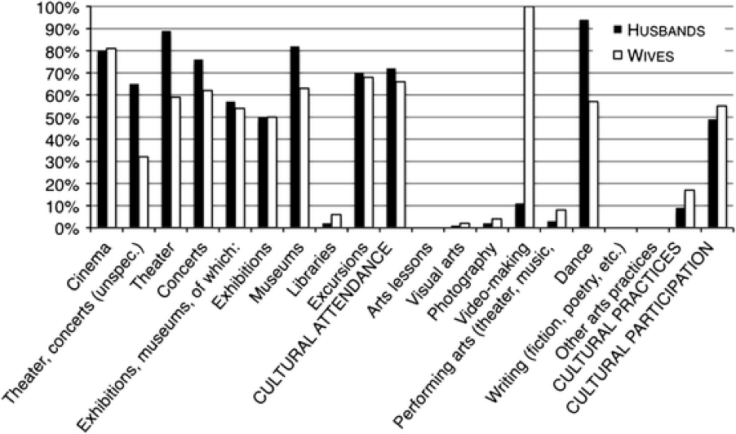By Elisabetta Lazzaro and Carlofilippo Frateschi
How can we measure the value of arts activities and practices taking into account individuals’ interactions? Is there a difference between participating in the arts when people are together or alone? We provide an alternative measurement of the economic value of the arts based on time use applied to couples’ participation offering useful insights to arts programmers, cultural policy makers and the society as a whole.
Arts participation is a complex activity determined by a combination of factors, including economic ones, but also the level of education, previous cultural participation and socio-economic situation. In particular, arts participation can take place in interaction with other individuals, who can enrich such an experience. The time dimension plays a fundamental role, especially when it involves interaction, togetherness and coordination.
In Couples’ arts participation: Assessing individual and joint time use we provide an alternative measurement of the value of the arts, based on the amount of time that individuals allocate to arts activities, alone and together. By exploiting the detail of large national time-use data, we look at social interactions taking place in arts participation by focusing on one fundamental social unit—couples—and by considering the joint arts participation of spouses. We examine not only the likelihood of their participating in the arts but also the factors that determine the amount of time couples dedicate to the arts and how partners may influence each other. The country under consideration—Italy—is distinguished not only by an extremely rich cultural supply but also by striking gender inequalities in terms of paid and unpaid work distribution between spouses. This has repercussions on both the free and discretionary time, in which arts participation could take place.
We find that Italian couples dedicate a small fraction of their day to arts participation, generally preferring attending art events than practicing some form of art themselves. Nevertheless, their average time allocation for the arts is higher than in other countries. Not surprisingly, given the particularly unbalanced division of paid and unpaid work in this country and women’s reduced access to leisure, we show that Italian husbands participate more and allocate more time to arts activities and practices than do their wives. We also show the existence of a variety of gender patterns in engaging individually or jointly in the different arts, and the distribution of time intensity during the week. Remarkably, Italian couples turn out to spend together half of the time they dedicate to cultural activities (see Figure 1), which suggests the importance of arts activities as moments of social interaction, reward and coordination.
Figure 1. Proportion of time spouses spend together on arts activities on an average day

We further disentangle the personal and mutual influence of partners’ socio-economic characteristics on individual and joint arts participation and allocated time. Our results confirm the presence of gender patterns and roles in arts participation and time use. People with a history of cultural participation tend to engage more as well as people with higher level of education, particularly the wives; women have a stronger social role than men in the engagement of couples in the arts.
The positive effects of males’ working conditions suggest the relevance of economic factors but also coordination effects within couples. Similarly, the presence of children in the household suggests alternative roles in the family in terms of arts companionship. Finally, our results show that arts participation and the amount of time allocated to the arts has a positive impact on individual and collective well-being, such as partners’ health and couple satisfaction.
In conclusion, our study demonstrates that time use can be a valid and accurate measurement of the value individuals and groups place in arts participation in terms of intensity, besides frequency. Therefore, time-use analysis can provide interesting insights to programmers of a variety of arts organisations and events, such as theatres, museums, arts centres, festivals, etc. to better match their offer to individuals’ and families’ characteristics as well as weekly schedules, and tailor their promotions to more sensitive and driving members within households. From a policy perspective, our study demonstrates the importance of arts participation for both individual and collective well-being and for social cohesion.
This article is based on:
Lazzaro, Elisabetta, and Carlofilippo Frateschi. 2015. “Couples’ arts participation: Assessing individual and joint time use”, Journal of Cultural Economics. DOI: 10.1007/s10824-015-9264-3.
Author Information:
Elisabetta Lazzaro is Professor of Creative Economy at HKU University of the Arts Utrecht.
Carlofilippo Frateschi has been Associate Professor of Political Economics at the University of Padova.
Image:
Idyll (2011) by Hernán Piñera. CC BY-SA 2.0 license.

Fascinating subject!
Can you please clarify what the chart in Fig. 1 is depicting? It’s described as “Proportion of time spouses spend together on arts activities on an average day”…yet it charts husbands and wives individually.
LikeLike
Thank you for your comment “M”.
In Figure 1 you can see the proportion of the average daily time couples’ members, namely husbands and wives, spend with each other out of their total time (alone and together) on arts activities and practices.
For instance, husbands and wives spend each about 80% of their total cinema time together, meaning that the remaining 20% of their time they go to the cinema alone or with somebody else. As we can notice, for theater and concerts this is no longer symmetrical: for theatre in particular, husbands share almost 90% of their total theatre time with wives, while wives share almost 60% of their total theatre time with husbands, meaning that wives spend relatively more time alone or with somebody else rather than with their husbands at the theatre; vice versa, when husbands go to theatre, they rather go with their wives. Etc. for the other arts activities and practices.
For more information please have a look at our article (http://link.springer.com/article/10.1007/s10824-015-9264-3, free access).
LikeLiked by 1 person